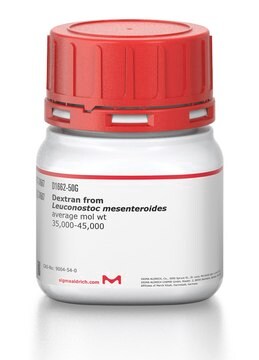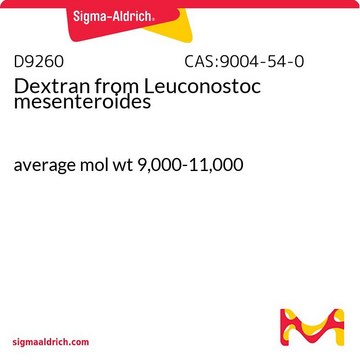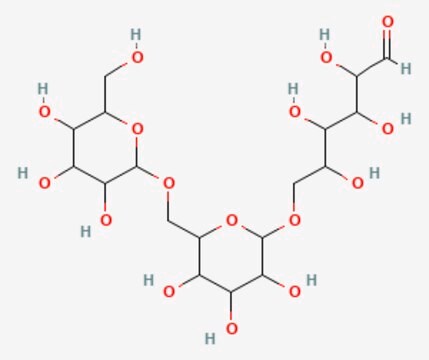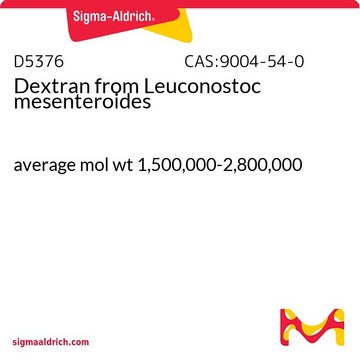31389
Dextrano from Leuconostoc spp.
Mr ~40,000
Sinónimos:
DEXTRAN 40
About This Item
Productos recomendados
biological source
(Leuconostoc spp)
Quality Level
form
powder
mol wt
Mr ~40,000
technique(s)
cryopreservation: suitable
gel permeation chromatography (GPC): suitable
loss
≤7% loss on drying
color
white
mp
483 °C ((901 °F ))
solubility
water: 1.5, clear, colorless
absorption
≤0.05 at 375 nm in H2O at 10%
suitability
suitable for additive or modifier in the separation of proteins or peptides
application(s)
advanced drug delivery
agriculture
sample preparation
storage temp.
room temp
InChI
1S/C18H32O16/c19-1-5(21)9(23)10(24)6(22)3-31-17-16(30)14(28)12(26)8(34-17)4-32-18-15(29)13(27)11(25)7(2-20)33-18/h1,5-18,20-30H,2-4H2
InChI key
FZWBNHMXJMCXLU-UHFFFAOYSA-N
¿Está buscando productos similares? Visita Guía de comparación de productos
General description
Application
- to mix with embryo suspension in seawater to prepare the sample for cryo-imaging
- to immerse the tails of zebrafish larvae for cryoimmobilization
- in the synthesis of vinyl sulfone modified dextran (DX-VS)
- in the synthesis of methacrylate functionalized dextran via ester linkage (DX-O-MeA)
- as a supplement in NCTC-135 tissue culture medium to prepare the perfusion medium
Dextran 40 is used in the development of new improved preservation solutions for organ transplantation. Dextran 40 may be used to determine cell tightness and flux parameters across cell layers. Dextran 40 is used as a colloidal plasma volume extender.
Biochem/physiol Actions
-Cryoprotection: Dextran acts as a cryoprotectant by forming a protective barrier around cells and tissues during freezing. This barrier inhibits the formation of ice crystals, which can damage cell membranes and structures.
-Viscosity Control: Dextran can alter the viscosity of solutions by increasing the molecular weight of the solution. This change in viscosity affects the flow properties of the solution, making it useful for controlling the thickness of solutions in various processes.
-Drug Delivery: Modified dextran serves as a carrier for controlled drug delivery. Dextran can encapsulate drugs and release them gradually, enhancing drug solubility and controlling the release profiles to improve therapeutic outcomes.
-Gel Electrophoresis: Dextran increases the density of sample loading solutions in gel electrophoresis. This increased density helps samples sink into the gel matrix, allowing for more precise separation of molecules based on size and charge during electrophoresis.
-Enzyme Stabilization: Dextran stabilizes enzymes by providing a protective environment. It forms a stable matrix around enzymes, enhancing their activity and extending their lifespan in various biochemical reactions. This protection prevents enzyme denaturation and inactivation, allowing enzymes to function more effectively.
Features and Benefits
- Dextran with an average molecular weight of 40,000
- Freely soluble in Water, DMSO, formamide, ethylene glycol, and glycerol
- Versatile and adaptable for various laboratory and research applications
Other Notes
Comparable product
Storage Class
11 - Combustible Solids
wgk_germany
WGK 2
ppe
Eyeshields, Gloves, type N95 (US)
Certificados de análisis (COA)
Busque Certificados de análisis (COA) introduciendo el número de lote del producto. Los números de lote se encuentran en la etiqueta del producto después de las palabras «Lot» o «Batch»
¿Ya tiene este producto?
Encuentre la documentación para los productos que ha comprado recientemente en la Biblioteca de documentos.
Los clientes también vieron
Contenido relacionado
Learn about C6H10O6 or dextran formation, classes and naming from MilliporeSigma. Dextrans are polysaccharides with molecular weights ≥1,000 Dalton, which have a linear backbone of α-linked d-glucopyranosyl repeating units.
Nuestro equipo de científicos tiene experiencia en todas las áreas de investigación: Ciencias de la vida, Ciencia de los materiales, Síntesis química, Cromatografía, Analítica y muchas otras.
Póngase en contacto con el Servicio técnico










